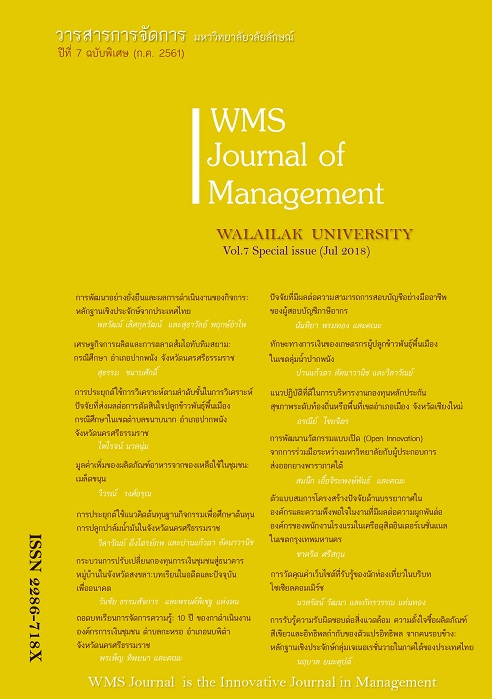Application of Concept of Activity-Based Costing (ABC) in Oil Palm Plantation Costing in Nakhon Si Thammarat Province
Main Article Content
Abstract
The purposes of this research were to 1) study activity-based costs of oil palm plantation in Nakorn Si Thammarat, and 2) to provide suggestions for cost reduction in oil palm plantation. Questionnaires were used to collect data from 393 palm oil farmers. The findings were obtained through studying the cost of each activity versus age range, and identifying the value-added activities and non-value-added activities. According to the results of this study, the average cost of the five plantation activities through all four age ranges was 148,354 Baht per Rai, and the highest cost activities were the harvesting activities and transporting activities, particularly of the 6-15 year-old oil palms. Furthermore, the findings suggested the farmers to omit some non-value-added activities, including the replanting activities and pest control activities, which had relatively small impact on the product quantity. To sum up, the cost and time required in the plantation will definitely be reduced, when these non-value-added activities are omitted from the entire process.
Article Details
References
Bongkoch Anangkapan. (2009). The Application of Activity-Based Costing for Calculation of Student’s Cost Faculty of Management Science. Princess of Naradhiwas University Journal. 3(2552). 33-47.
Boontaree Chanklap and others. (2011). A Study of the Appropriate Supply Chain Management to Support the Expansion of Oil Palm Plantation in Pakpanang Basin and Adjacent Area in Nakhon-sithammarat Thailand. The Thailand Research Fund (TRF).
Chairatna Nilnond and Teerapong Channiyom. (2008). Effective Management of Oil Palm Plantations. Retrieved November 12, 2015. From http://fieldtrip.ipst.ac.th/intro_sub_content.php?content_id=20 & content _folder_id=234.
Danuja Kunpanitchakit. (2014). Activity–Based Management. Retrieved November 12, 2015. From http://www.chulapedia.chula.ac.th.
Duangmanee Komaratat .(2003).Cost Accounting (in Thai). 9ed.Bangkok: Chulalongkorn University Press
Fatah, A. M. and Mat-Zin, R. (2013). “Understanding the Current Practices of Cost Accounting Systems in the Libyan Agricultural Firm: Evidence from Six Libyan Agricultural Firms”, International Journal of Scientific and Research Publications, 3(8), 1-6.
Fatah, A. M. and Mat-Zin, R. (2014). “Literature Review of the Practice of Cost Accounting System in the Agricultural Firms”, Journal of Commerce and Accounting Research, 3(1), 16-20.
Federation of Accounting Professions. (2015). Draft TAS 41 Agriculture (Revised 2009). Retrieved November 12, 2015. From http://www.fap.or.th
Foong, F.-Y. and Teruki, N. A. (2009). “Cost-system functionality and the performance of the Malaysian palm oil industry”, Asian Review of Accounting, 17(3), 212-225.
Gonzalez-Gomez, J.I. and Morini, S. (2009). “A model for cost calculation and management in multiproduct agricultural framework. The case for ornamental plants”, Spanish Journal of Agricultural Research. 7(1), 12-23.
Information Center Department of Agriculture. (2015). Report on the status of crop production, Group of perennials of oil palm plantations in Nakhon Sri Thammarat. Retrieved November 12, 2015. from http://production.doae.go.th
Kanjana Boonkaew. (2013).Cost Behavior of Oil Palm Plantations Using Activity-Based Costing System: A Case Study of Lamae, Chumporn Provinc. (in Thai) Master Degree’s Thesis, Ramkhamhaeng University.
Lee, T.-R and Kao, J.-S. (2001). “Application of simulation technique to activity-based costing of agricultural systems: a case study”, Agricultural System. 67(2001), 71-82.
Liu, L.Y.J. and Pan, F. (2007). “The implementation of Activity-Based Costing in China: An innovation action research approach”, The British Accounting Review 39(2007), 249-264.
Manion, J. (2003). Joy at work: Creating a positive workplace. Journal of Nursing Administration, 33 (12). 652-655.
Office of Agricultural Economics. (2014). Information on agricultural production. Retrieved November 12, 2015 http://www.oae.go.th
Oluwagbemiga, O.E., Olugbenga, O. M. and Zaccheaus, S. A. (2014). “Cost Management Practices and Firm’s Performance of Manufacturing Organizations”, International Journal of Economics and Finance, 6(6), 234-239.
Pannipa Rodwanna. (2015, May 16-17). Agricultural Cost Accounting. The training document of Federation of Accounting Professions, pp 1-5.
Patchanit Naovapun. (2012). Cost Accounting (in Thai). Bangkok: Kasetsart University Press.
Poramet Sirithanarod. (2009). The costs and return analysis of oil palm plantation : a case study Tumbon Saikhao, Amphoe Khlongthom, Krabi Province. (inThai) Master Degree’s Independent Study, Kasetsart University.
Roztocki, N. and Schultz, S.M. (2003). “Adoption and Implementation of Activity-Based Costing: A Web-Based Survey”, State University of New York at New Paltz.
Theera Eksomtramage. (2011). Oil Palm Breeding. Songkhla: Research and Development Office, Prince of Songkhla University.
Somnuk Aujirapongpan (2006). Cost Accounting 1. 1ed. Bangkok: Physics Center Press.
Somthong Khakay and Vorasak Tommanon. (2010). Activity cost accounting (in Thai). Teaching of Cost Accounting and Management Accounting (Unit 9). Nonthaburi: Sukhothai Thammathirat Open University.
Supanee Preechachote. (2009). Cost-benefit analysis of palm oil for investment in Pak Panang Basin ,Nakhon Si Thammarat province. (in Thai) Master Degree’s Thesis. Sukhothai Thammathirat Open University.
Supornrat Petthong. (2012). Cost-benefit analysis of palm oil plantation : a case study of Sutthinan farm in Nakhon Si Thammarat province. (in Thai) Master Degree’s Thesis. Mae Fah Luang University.
Sureeporn Jaruwat. (2002). COST ACCOUNTING (in Thai). Bangkok: TPN Press.
Suwat Makin. (2014). Preparation of oil palm plantation and growing areas. Retrieved November 12, 2015. From http://jitpisutsukyoy55.wordpress.com
Wijittra Pulpemshup. (2001). Principle of cost accounting (in Thai). 4ed.Bangkok: Kasetsart University Press.


